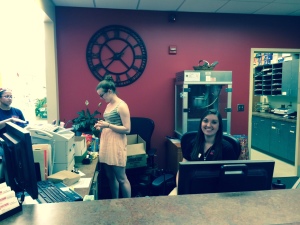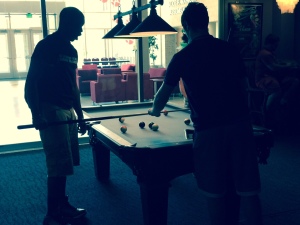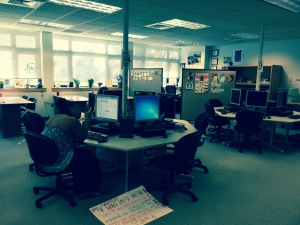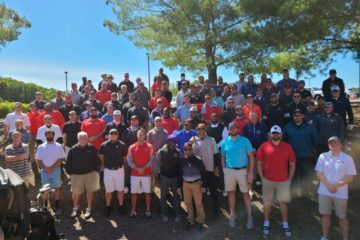Short Changed: How Maryland’s Minimum Wage Increase is Affecting Student Jobs at Frostburg State University
Some might say the Lane University Center at Frostburg State University is the heart of the campus, as it is, arguably, the only building on campus devoted entirely to students.
Lane is the social and cultural hotspot of FSU.
“The students are the heart and soul: not only the student body, but the student employee,” said Rob Webber, the director of the Lane University Center. “The students are the lifeblood of what we do.”
Not only does the building exist to provide services for students, it also provides jobs for students.
“Without the student employees, this building could not function,” he said, adding that students manage the building on evenings and weekends. “It takes a certain amount of student staff to operate this facility. We need five managers, we need six game room folks, and we need five info desk staff.”

Many of these student workers are paid minimum wage, which increased from $7.25 to $8.00 on January 1, 2015.
After Maryland’s minimum wage increase went into effect, student workers had to be paid more, and the building’s hours were subsequently cut. Instead of opening at 10 am on Saturdays, the Lane Center opens at noon. On Sundays, the building doesn’t open until 5 pm.
The increased payroll left Webber with few options to adjust the building’s operations.
“We didn’t have a choice but to reduce the hours in order to cover the [payroll] shortfall that we were going to have,” said Webber. “We can slash the number of staff we have but it doesn’t eliminate that our operation needs to be here to support our campus constituents and our campus community for a set number of hours in a day.”
Keeping the building open at the previous hours would have cost $5,000 more per year. Webber says payroll for the Lane Center’s student workers amounts to about $76,000 this year. Thirty-six students hold positions in the building, and each worker averages around 10-20 hours per week.
“Our operation grew significantly when we opened the new building in January of 2011, and our budget did not increase,” said Webber. Among the new services offered by the center were an improved game room, more technical services, a fitness center, and reservation services.
Reservations, which are made by student organizations for meetings and activities, have declined, likely due to the reduced hours. Sunday afternoons used to be the “prime time” for student organization reservations, according to Webber.
With several more rounds of minimum wage increases on the way, the building’s hours might be cut even more, unless funding is increased. However, the Lane Center hasn’t seen an increase in funding since the building was renovated, despite employing a larger staff and offering more services, according to Webber.
More funding, though, would mean a higher fee for students.
David Rose, vice president for administration and finance, said, “When we put the budget together for this year, knowing that the minimum wage was going to go up, we gave each [state funded] division an increase.”
While cuts were minimal on the state supported side of the payroll budget, due to additional revenue coming from state appropriations, “your areas like athletic fees and Lane Center operating fees– those areas have to operate within the fee that’s collected from the students,” said Rose.
“I can’t add money to that. It comes from student fees,” he said.
Due to the constant fluctuation of enrollment, student fee-supported budgets also fluctuate.
Because work study students are paid through state and federal appropriations, there hasn’t been a reduction in the number of work study students.
Dr. Daniel Mizak, a professor in FSU’s economics department, said, “I know in our department–each dept has a budget for work study students–and at the beginning of the year after the minimum wage went up we basically told our work study students they were going to get fewer hours. Nobody got fired.

“Turns out, though, that the administration found some extra money in the budget to put it into the work study program, so we didn’t have to reduce hours,” he continued.
As a result of low fees and declining state appropriations, funding is low and several areas on campus are struggling to fight the higher payroll.
“Right now, with a high minimum wage, firms really like to, maybe not necessarily let people go, but I know they’re cutting back hours,” said Mizak.
To avoid cutting more hours next semester, the Lane Center needs approximately $13,000. Webber says “the problem is only going to get worse.”
Other places of student employment have not suffered cuts yet, but they may be on the horizon.
Mark Smith, who is the director of FSU’s tutoring center, said, “We’ve always paid more than the minimum wage, obviously, to try to remain competitive” with jobs in fast food and retail. “We always try to stay ahead of the minimum wage. Our current starting pay is $8.50.”
“We actually have a pay scale based on the number of tutoring hours and the number of training hours,” said Smith. “As of now, we’re able to pay the tutors those rates.”

The tutoring center did recently cut about 30 tutoring positions, but this was due to new research on tutoring practices, not the minimum wage increase.
“We just recently switched the way that we offer our tutoring services, because outside of the computer science [tutoring], it’s all center based and appointment-based,” said Smith. “So we went from 90-some tutors to 60.”
“It wasn’t so much that the minimum wage increase being the driving force behind the change,” he continued. “It was the research of the appointment-based model that guided our judgment about making the change about how we deliver the services.”
“[The change] came out positive, really. Now down the road, I’m not sure, because we don’t know what kind of cuts are coming in the future.”
With a 25 cent minimum wage increase coming on July 1, 2015, cuts may come next semester.
“It hurts us that we have to think about [reducing building hours,] said Webber. “That’s obviously not what I want. This is the student’s building. The students pay for this building. This is absolutely the only building on campus, if you really think about it, that is here solely for students. That’s the whole purpose, from being a social environment where you can just come and hang out, to having activities and services and programs, to having food service. The sole purpose is for students.”





1 Comment